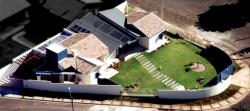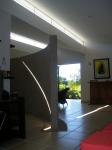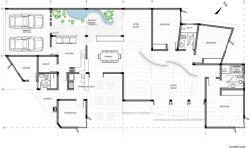Due to the shape of the site and the idea of leaving as much free space as possible, the house was set at the rear of the site, opening to the surrounding perspectives. Set this way, the main elevation faces southeast, losing therefore, much of the natural ventilation and sunlight in the interior, leading to the solution of fragmenting the roof to make it visually permeable, creating tension points and ruptures from the unit.
The house develops on a single level, with living and dinning areas, kitchen, pantry and laundry area, two bedrooms, bath, master bedroom with bath, an atelier, a workroom and a barbeque area.
Through the architecture, the parts intercommunicate, interfere with one another and unite, de-characterizing the limits of the program; purposefully breaking angles and in relation to the linear pattern of the floors, invade and give movement to the spaces.
The truncated parts, through pergolas and planes unequally set from one another, creating openings along their extensions (vertical continuity), form a skin that not only covers but also peels, opening the interior and giving life to its essence; interacting and joining with nature, capturing sunlight. Making it, in a certain way, an autonomous unit, saving energy (as do the solar heating panels that heat the water)
The roof of ceramic tiles with few plans, converses with the regional context in which the house is inserted.
Once inserted in this context, the house breaks with repetition, creating within itself, opposing relations that mark a non-comparable identity.
As a music analogy, and as mentioned on David Dunster text ( AR 1307 – Jannuary 2006) “ Stravinsky has said of his music, now usually in form, that he is interested not in harmony but in related densities of intervals.”, reforcing the truncated parts, as well functional, that gives new roof rhythm till then harmonious with the environment.
The architecture, now broken, no longer joins geometries to qualify spaces and justify them as rooms, but gives the limits movement and changes ones perception.
1999
2000
.jpg)
.jpg)


.jpg)


.jpg)
.jpg)

